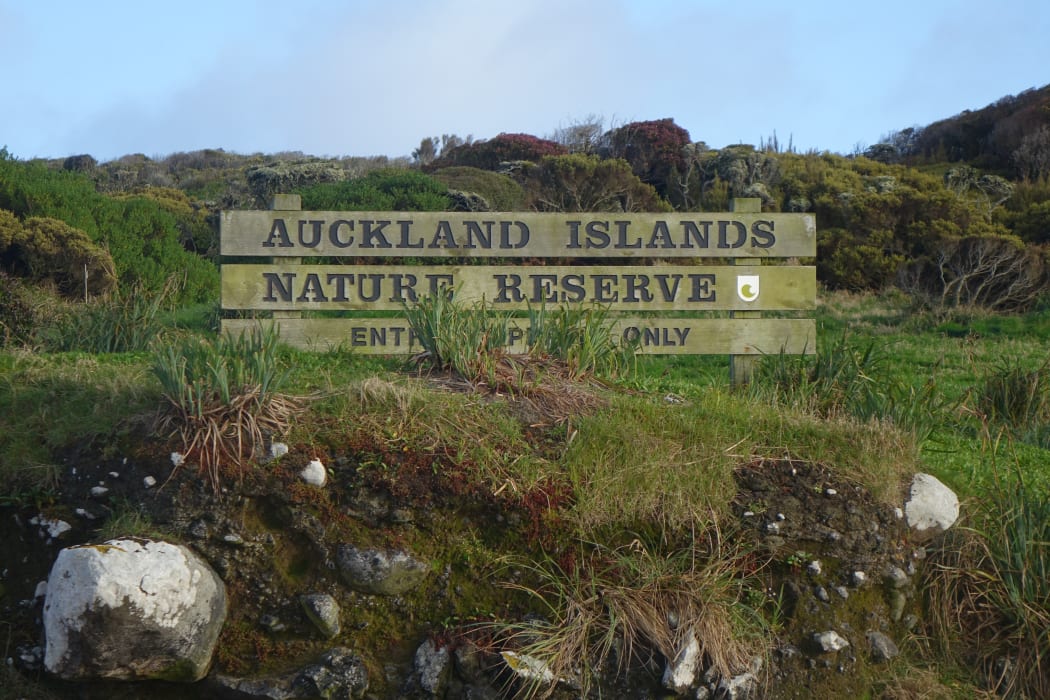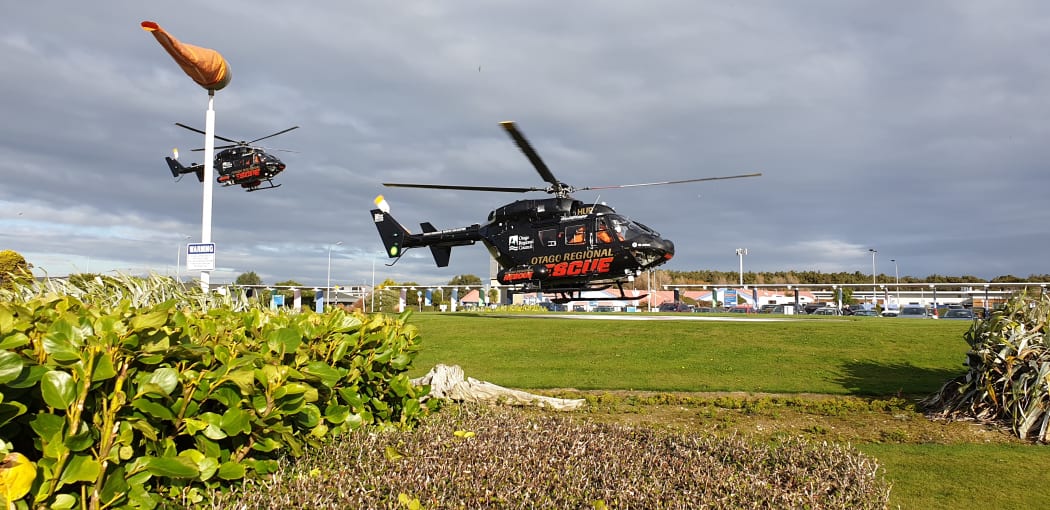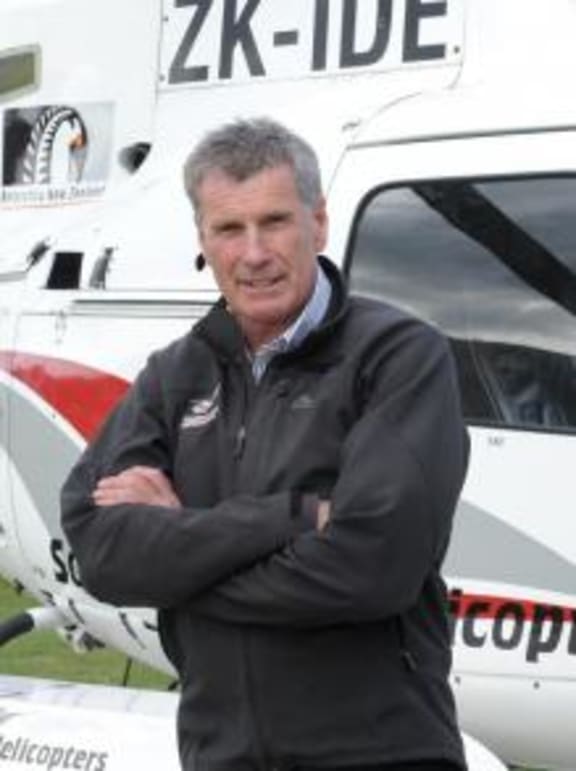The Transport Accident Investigation Commission has begun investigating the helicopter crash in subantarctic waters of the Southern Ocean on Monday night.

The missing helicopter crew were found on a beach in the Auckland Islands. Photo: RNZ / Ian Telfer
The survival and rescue of Lester Stevens, Andrew Hefford and John Lambeth on board has been hailed as miraculous.
The crew of the Kawasaki BK-117 helicopter were wearing survival gear and lifejackets when they crashed 3km from the Auckland Islands, 450km south of New Zealand.
They managed to get ashore on the main island where they made a shelter to keep warm until help arrived.
A fishing boat spotted a door from the helicopter which helped narrow down the search area.

Two helicopters transport three rescued crew members to Southland Hospital in Invercargill. Photo: RNZ / Tess Brunton
One of the pilots who was part of the rescue mission, Sean Mullally told Morning Report it was unbelievable that the three survived the crash.
"We were ecstatic," he said as he recalled spotting two of the three members.
For a start, he said two out of three "is good" but as they went down, they saw all three.
"It was unbelievable to see them still alive. It was a great moment."
When he set out on the rescue mission, he didn't think the prospects were good.
"It was a very long flight to the Auckland Islands and we got the phone call not long after we left base," he said.
"We knew they were in the water."
He said the weather yesterday was typical to Auckland Islands - just drizzly, clouds, but it was quite warm.
Mr Mullally said the three were easy to spot because of the "big orange jackets, floats that they had on".
He said they then flew down the path that the helicopter might have taken to get to the hut.
He based his movements on the experience of being there before.
"They were wondering when we were going to turn up," he said.
"It was pretty emotional down there. It was good to see them, all three, alive really."
Three discharged from hospital
All three survivors of Monday night's helicopter crash off the subantarctic Auckland Islands have now been discharged from hospital.
The pilot Andrew Hefford was released from Southland in Invercargill this afternoon.
Lester Stevens and John Lambeth were discharged earlier.
Two investigators from the Transport Accident Investigation Commission have been on the ground in Te Anau today.
They have begun interviewing the three survivors as well as the aircraft operator Southern Lakes Helicopters.
Southern Helicopters will also conduct its own investigation into the crash
'We've won Lotto on that one'

Sir Richard Hayes Photo: SUPPLIED
Southern Lakes Helicopters, which owns the aircraft, said the investigation would need to find out why the emergency locator beacons failed.
Chief executive and chief pilot of the helicopter company Sir Richard Hayes said finding the three men alive is one of the highlights of his career.
He told Morning Report the crew onboard the rescue mission was expecting the worst.
"When it's one of your guys in your own company and it's close to home it turns into quite a mission alright," he said.
"We ended up with the best result you can imagine."
Mr Hayes said they had gone 15 hours without contact from the crew, and the relief of seeing the three men was overwhelming.
"It's probably one of the few times in anyone's life that they can't believe what they're looking at, especially when you're going on a mindset with a different result."
He said it's rare that an aircraft goes into the sea and people survive it.
"We were all astounded that the outcome was as good as what it was. It couldn't be better."
"We've won Lotto on that one, no doubt about it."
Investigation team headed south
An investigation has been launched into what caused the Kawasaki BK-117 helicopter to crash.
Transport Accident Investigation Commission's (TAIC) senior communications advisor Simon Pleasants said a two-person investigation team headed south today.
He said they would be conducting interviews with the three survivors and the operator of the aircraft, Southern Lakes Helicopters.
The investigators will also collect documentary evidence such as training and maintenance records.
"The crash site will be visited at some stage in the next several days," Mr Pleasants said.
"And at some stage during the process we will be talking to recovery experts about recovering the wreckage and removing it to the TAIC's technical facility in Wellington.
"I imagine [that would be] a difficult process and the technical advice we have will be key to that decision."
Mr Pleasants said the commission often issued an interim report if it uncovered an urgent issue which it felt the industry needed to pay attention to as soon as possible.
He said a complete report often took around 18 months.
Regular storms, strong winds in 'that part of the world'
Otago University marine science lecturer Gary Wilson who regularly goes to the area for research said water temperatures were very cold.
"Shallow waters maybe only 15 to 20m where they were, but still - yes - very cold water. The hypothermia would have kicked in rather quickly I would think," he said.
"It's often referred to as the Antarctic Riviera. As you head south from New Zealand you don't have to go that far to get into the Antarctic circumpolar current so it's really quite a separate environment from here in New Zealand.
"You go south, you track into colder and colder temperatures quite quickly, and I'm sure the water temperatures down there would have been close to single digits if not single digits so they would have been pretty cold and when you get into that part of the world there are quite regular storm fronts and very strong westerly winds."
He said the helicopter crew would have had to scramble up onto a wave-worn rocky platform.
"The Auckland Islands are volcanic and most of the coastal region of the island ends in coastal cliffs with some wave-cut platforms on them so to call it a beach would have been perhaps a bit romantic.
"They would have had to scramble up out of the water into that area, but the region they were in was in Port Ross so they were lucky to be in a relatively safe harbour there rather than out in the more open ocean."
He said the islands were a world heritage site administered by the Department of Conservation. There were tourism operators but they couldn't land without a permit.


